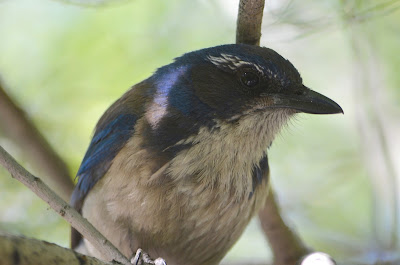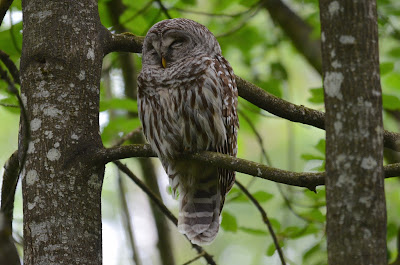The California Scrub-Jay (Scientific name - Aphelocoma californica) is one of two species (the other Woodhouse's Scrub-Jay) that were formerly both known as the Western Scrub Jay. These birds range from the Baja Penninsula in Mexico up to the Pacific Northwest. They display a deep blue head, neck, wings and tail and a brownish grey back and light grey underparts. They have a blue head with a white eyebrow stripe. Bill is dark and straight with a slight hook at the end. The similar Woodhouse's Scrub-Jay is found in the more eastern parts of California and into Nevada and down into central Mexico. Photos taken at Big Morongo Canyon Preserve, Morongo Valley, California in May 2016.
In addition to lighthouses, I have taken many photos of birds at home and on my travels. Thought I would share them as I have my lighthouse pictures. Hope you enjoy. Cheers, Neal
Friday, September 9, 2016
Black Phoebe
The Black Phoebe (Scientific name - Sayornis nigricans) is a flycatcher found in the south western United States, Mexico and down into South America. They are a small bird and have dark (grey/black) upper parts and chest, a white belly and a dark head. The head is large and often displays a crest. Photos taken in Palm Springs, California in May 2015 and 2016.
Barred Owl
The Barred Owl (Scientific name - Strix varia) is a large stocky owl with a round head and no ear tufts. They are a mottled brown and white and have dark eyes. The underparts have vertical brown bars on a white background while the upper breast has horizontal brown bars. Wings are barred brown and white. They have a yellow beak. The photos were taken in June 2016 in Langley, British Columbia. The third photo is of two of this year's owlets.
Barn Owl
The Barn Owl (Scientific name - Tyto alba) is a medium sized owl found throughout South America, most of the United States and southern British Columbia and Ontario. They a rounded head with a heart-shaped face and dark eyes. They have no visible ear tufts. They are pale brown and grey overall and have speckling on the breast and back. They display some dark barring on the wings. They are nocturnal and rely heavily on their acute sense of hearing when hunting. Photos taken in Abbotsford, British Columbia in August 2016.
Great Kiskadee
The Great Kiskadee (Scientific name - Pitangus sulphurous) is a large flycatcher found throughout much of South America, Central America, Mexico and as far north as southern Texas. They have large black and white striped head with a heavy black bill. Their underparts are a bright yellow and they have reddish-brown wings and back.They are a very vocal bird with a loud kid-ka-dee call. They are one of the most widespread flycatchers in the Western Hemisphere. Photos taken March 2016 at Dona Ana Beach, Puntarenas, Costa Rica.
Wednesday, September 7, 2016
Scarlet Macaw
The Scarlet Macaw (Scientific name - Ara macao) is a large colourful South American parrot. They range from south-eastern Mexico into Brazil, Venezuela, Bolivia, Colombia and Amazonian Peru. They are the largest species of parrots in the world. They have a creamy white face and large white beak. Their plumage is mainly red with blue and yellow feathers along the wings. They have long red tail feathers. They are the national bird of Honduras. Photos were taken in March 2016 in Aranjues, Costa Rica.
Bananaquit
The Bananaquit (Scientific name - Coereba flaveola) is a passerine that is found from the Caribbean and Mexico down into South America as far as Northern Argentina. They are a small bird with dark grey to black back and wings and bright yellow underparts. The head is dark grey to black with a noticeable white eyestripe. They have a black down curved bill. There are a number of variations of the species throughout its distribution. These photos taken in March 2016 in Oranjestad, Aruba.
House Wren
The House Wren (Scientific name - Troglodytes aedon) is a small fairly plain looking brown bird and is found throughout the Western Hemisphere from the tip of South America to the north of the Canadian Provinces. The House Wren is brown overall with dark barring on back and wings. They have longish tails and a long thin slightly curved bill. They have a faint eyebrow. Photos taken on Saltspring Island, British Columbia in June 2016.
Green Heron
The Green Heron (Scientific name - Butorides virescens) is a small heron that can be found from northern South America to as far north as southern Canada, although not found in mountains of the western U.S. They are a very colourful bird, with deep green on the back and a chestnut to almost purple breast and neck. Wings are a dark grey. They have a dark green crown and dark upper bill with a yellow patch in front of the eye. Legs are yellow and not overly long. Photos taken in Abbotsford, British Columbia in summer 2016.
Hairy Woodpecker
The Hairy Woodpecker (Scientific name - Picoides villosus) is very similar in appearance to the Downy Woodpecker. It is however larger and has a longer bill. The head is square and it has long tail feathers. The breast is white and the back is black and checkered white. The Hairy has two white stripes on the head and males have a red patch at the back of the head.
They can be found throughout North America. These photos taken April 2014 (back view) and April 2016 at the Great Blue Heron Nature Reserve in Chilliwack, British Columbia.
They can be found throughout North America. These photos taken April 2014 (back view) and April 2016 at the Great Blue Heron Nature Reserve in Chilliwack, British Columbia.
Red-bellied Woodpecker
The Red-bellied Woodpecker (Scientific name - Melanerpes carolinus) is found in the eastern part of the United States from southeast Texas to Florida and as far north as the southern great lakes. They are medium sized with a round head and a black and white striped back. They have a red cap and nape and a small amount of red on the belly. In size they are similar to the Hairy Woodpecker. Photos taken in August 2016 in Tavernier, Florida
Snowy Egret
The Snowy Egret (Scientific name - Egretta thula) is found throughout South and Central America, the Caribbean and into the Southern United States. They are a medium sized heron with long black legs and yellow feet. The bill is black with a patch of yellow skin at the base. Plumage is white. Photos taken in Cartagena, Columbia (top two) in March 2016 and at Lake Tohopekaliga, Kissimmee, Florida in August 2016.
White-crowned Pigeon
The White-crowned Pigeon (Scientific name - Patagioenas leucocephala) is a bird found in the Caribbean and into Southern Florida. It is a fairly large pigeon with mostly slate grey body and white cap on its head that extends down to the eye level. The eyes have a white iris and the bill has a pale tip. These birds are very fast in flight and their food is mainly fruit of hardwood trees. Photos taken on Big Pine Key, Florida in August 2016.
Limpkin
The Limpkin (Scientific name - Aramus guarauna) is a unique bird found in South America and as far north as Florida. It is a large brown bird somewhat resembling an Ibis or spoonbill, but are more closely related to rails and cranes. It forages in the swamps for molluscs with it's main diet being of apple snails. It has a distinct cry which has caused it to be known as the crying bird in some areas. The Limpkin has a long, slightly down curved bill, a long neck and long legs. Photos taken at Lake Tohopekaliga, Kissimmee, Florida in August 2016.
Subscribe to:
Comments (Atom)












































